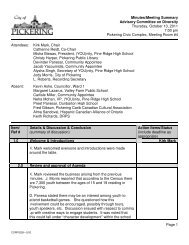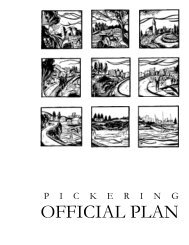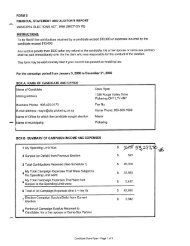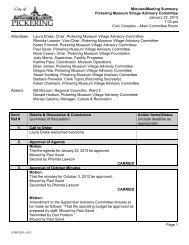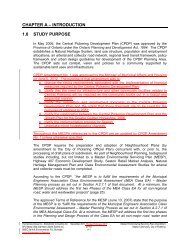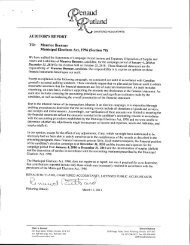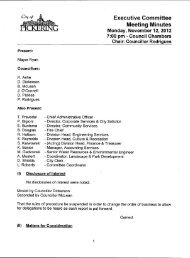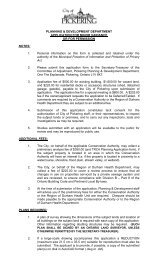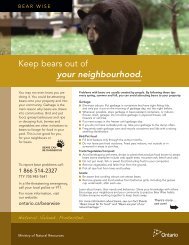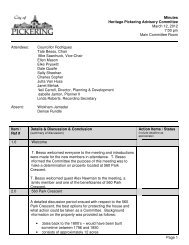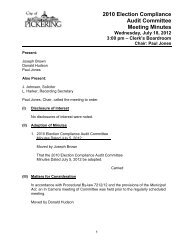foreword - City of Pickering
foreword - City of Pickering
foreword - City of Pickering
Create successful ePaper yourself
Turn your PDF publications into a flip-book with our unique Google optimized e-Paper software.
<strong>City</strong> <strong>of</strong> <strong>Pickering</strong> January 2003<br />
Safer Streets Traffic Management Strategy<br />
______________________________________________________________________________<br />
6.2.6 Glendale Drive<br />
The announcement <strong>of</strong> the proposed phased urbanization <strong>of</strong> Glendale Drive between<br />
Glenanna Road and Finch Avenue in 1996 and 1997, resulted in an increase in resident<br />
concerns about vehicle speeding. Although Glendale Drive residents did not discourage<br />
the urbanization project, certain aspects including increased traffic speeds and volumes<br />
were concerning. Residents, Council members and staff viewed the recent traffic<br />
calming pilot projects introduced in other areas <strong>of</strong> the <strong>City</strong> and the Province as a possible<br />
means <strong>of</strong> addressing these specific issues. A mandate was given to traffic calm Glendale<br />
Drive as a pilot project during the reconstruction process. With the clear direction that<br />
speed humps would not be permitted on Glendale Drive, the types <strong>of</strong> traffic calming<br />
measures were limited to visual changes and a shift in horizontal alignment. Following<br />
an extensive interview with each resident on Glendale Drive the introduction <strong>of</strong> chicanes,<br />
patterned asphalt and a vertical element consisting <strong>of</strong> a boulevard tree was constructed<br />
over a two year period.<br />
6.3 ANALYSIS OF PILOT PROJECTS<br />
To properly analyze the traffic calming pilot projects that have been installed throughout the <strong>City</strong><br />
<strong>of</strong> <strong>Pickering</strong> since 1996, a number <strong>of</strong> different initiatives have been completed. These initiatives<br />
include regular observations <strong>of</strong> the traffic calmed areas, undertaking traffic speed and volume<br />
studies, receiving comment from affected Emergency and <strong>City</strong> service agencies and the<br />
completion <strong>of</strong> a series <strong>of</strong> non-biased individual resident questionnaires from each traffic calmed<br />
area. The details <strong>of</strong> the various impacts and <strong>of</strong> the facts relating to the installation and long-term<br />
applicability <strong>of</strong> maintaining traffic calming measures on <strong>City</strong> streets are provided as follows:<br />
6.3.1 Impact on Vehicle Speeds<br />
The reduction <strong>of</strong> vehicular speeds in the traffic calmed pilot project areas is largely<br />
dependant on the type <strong>of</strong> traffic calming measures installed and the linear spacing<br />
between the individual features. Not surprisingly, speed humps have proven to be the<br />
most effective at reducing operating speeds, while less severe visual and physical<br />
measures such as entrance gateways, raised intersections, traffic calming circles and<br />
chicanes have reduced rates <strong>of</strong> effectiveness. It should not be discounted, however, that<br />
each measure remains very important to the overall concept <strong>of</strong> traffic calming. Each<br />
traffic calming project is unique in that the problems vary, the roadway alignments<br />
change and the mix <strong>of</strong> resident opinions may be very different requiring the consideration<br />
or use <strong>of</strong> specific traffic calming measures or techniques.<br />
6.3.2 Impact on Traffic Volumes<br />
The impact on traffic volumes is very similarly related to speed reduction. The type <strong>of</strong><br />
traffic calming measures used and the linear spacing between the features greatly<br />
influences the convenience level <strong>of</strong> the particular roadway. Speed humps tend to be much<br />
more inconvenient to motorists than raised intersections, traffic calming circles or<br />
26



